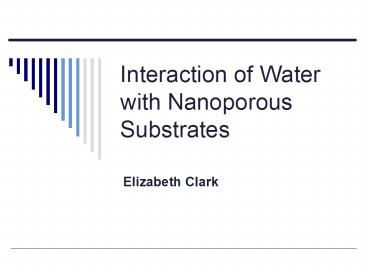Interaction of Water with Nanoporous Substrates - PowerPoint PPT Presentation
1 / 20
Title:
Interaction of Water with Nanoporous Substrates
Description:
The Cassie-Baxter Equation. Young's Equation3. Young's Equation ... The Cassie-Baxter equation gives the contact angle on a porous, homogeneous material ... – PowerPoint PPT presentation
Number of Views:263
Avg rating:3.0/5.0
Title: Interaction of Water with Nanoporous Substrates
1
Interaction of Water with Nanoporous Substrates
- Elizabeth Clark
2
Acknowledgments
- Dr. John Barnard Advisor
- Mr. Albert Stewart SEM Images
- Lawrence Weinstein and Sean Thaler Sputter
coating of substrates
3
Motivation
- In recent years, scientists have been
investigating surface phenomenon, including those
surfaces which produce high contact angles - An understanding of wetting behavior is
fundamental to water flow, water treatment, and
water contamination with new nano-materials. - Previous studies have prepared ultrahydrophobic
surfaces using elaborate techniques such as argon
plasma etching2. - However, in this experiment, commercially
available alumite filters, sputter coated with
different gold thicknesses, were used to observe
high contact angles.
In nature, there are some plants such as the
lotus (above) whose leaves exhibit high contact
angles due to surface roughness on a micrometer
level1.
4
Interaction of Water with Nanoporous Substrates
- The interaction of water with nanoporous alumite
filters was studied by observing the contact
angle on coated alumite filters. - Several equations are used to explain the contact
angle - Youngs Equation
- Wenzels Equation
- The Cassie-Baxter Equation
5
Youngs Equation3
- Youngs Equation
- Equilibrium contact angle of a smooth,
homogeneous surface
6
Wenzels Equation4
- Wenzels equation gives the contact angle on a
rough, homogeneous surface - cos ?rough r cos ?
- r-roughness factor the actual surface
area/geometric surface area - ?-contact angle on smooth material
7
The Cassie-Baxter Equation4
- The Cassie-Baxter equation gives the contact
angle on a porous, homogeneous material - cos ?porous f1cos? f2
- f1-fraction of fluid area in contact with the
material - f2-fraction of fluid area in contact with the air
in pores
8
Drop Shape Analysis System (DSA 100)
Needle and Dispensing System
Camera
Image
Sample Stage
9
Experimental Procedure
- Advancing contact angle measurements were made
by - Producing a drop 3.5µl in size
- Positioning the needle in the center of the drop,
just above the substrate - Adding 0.2µl of water to the drop, and using the
DSA 100 to measure the contact angle as it
advanced - Recording the largest contact angle measurement
- Evaporating Drops were observed by
- Dispensing a 0.4µl drop on the substrate
- Using the DSA 100 to record a contact angle and
drop diameter measurement and to take an image of
the drop regularly until the drop evaporated
10
Substrates
- Two substrates were used
- Standard Silicon wafers with an oxide layer on
the surface - Whatman Anodisc filters
- These porous alumina discs come in pore sizes of
20nm, 100nm, and 200nm. - The anodiscs and silicon wafers were
sputter-coated with gold to achieve three
different thicknesses 10nm, 50nm, and 100nm
11
Sputter-Coating
- In the sputtering process, the gold atoms do not
all follow a normal path to the substrate. In
fact, the gold particles follow a Gaussian
distribution as they deposit on the surface. - The range in deposition angles contributes to a
slight build-up of gold on the substrate walls,
and so the pore-size can be controlled.
12
20nm Alumite 100nm Alumite 200nm
Alumite
SEM Images of Gold-Coated Alumite Substrates
10nm Gold Coat
50nm Gold Coat
100nm Gold Coat
13
Advancing Contact Angles Results
14
Advancing Contact Angles on Uncoated and Gold
Coated Substrates
Porous Alumite (20 nm)
Porous Alumite (200 nm)
Flat Si wafer
No Gold
10 nm Gold
15
Evaporation Constant Contact Angle (Flat
Substrate)
Water on a silicon substrate with a 10nm thick
gold coating.
16
Evaporation Constant Drop Diameter (Porous
Substrate)
Water on an alumite disc with a 10nm thick gold
coating.
17
Summary of Results
- High contact angles were created by gold-coating
the nanoporous substrates - However, the receding contact angles as seen in
the evaporation of the drops, tended to zero for
the nanoporous substrates. - The low receding contact angle may be due to the
pores, which can pin the contact line - Because of the low receding contact, these
substrates are not water repellent they do not
slide off the surface.
18
Implications in Nanotechnology and the Environment
- Catalysts
- Different catalytic effects based on size, shape,
composition, and surface properties6 - Water Filters
- Ceramic filters with nanosized pores can filter
out bacteria and viruses7 - Self-Cleaning Surfaces
- Can use a surface with a high (many waterproof
surfaces) or low (TiO2) contact angle - Biomedical Applications
- Scaffolds for organ repair
- Release of medicine through time
19
Future Projects
- Repeat the experiment with different liquids
- Repeat the experiment with nanoparticles in the
liquid or on the substrate - Observe how water interacts with nanoparticles
20
Works Cited
- Blossey, R. Nature Materials 2003, 2, 304.
- Chen, W. Fadeev, A.Y. Hsieh, M. C. Öner, D.
Youngblood, J. P. McCarthy, T. J. Langmuir 1999.
15, 3395. - Tadmor, R. Langmuir 2004, 20, 7659.
- Youngblood, J. P. McCarthy, T. J. Macromolecules
1999, 32, 6800. - Dr. Barnard Paper
- Larsen, S. C. In Nanotechnology and the
Environment Applications and Implications Karn,
B. Masciangioli, T, Zhang, W. Colvin, V.
Alivisatos, P., Ed., American Chemical Society
Washington, D. C., 2005 p 268. - Schulenburg, M. Nanotechnology Innovation for
Tomorrows World, European Commission, Research
DG Berlin, 2004 p 38.

